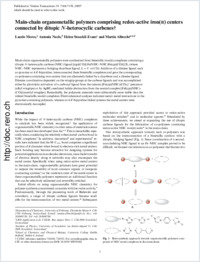Main-chain organometallic polymers comprising redox-active iron(II) centers connected by ditopic N-heterocyclic carbenes
- Mercs, Laszlo Department of Chemistry, University of Fribourg, Switzerland
- Neels, Antonia XRD Application Lab, CSEM, Neuchâtel, Switzerland
- Stoeckli-Evans, Helen Institute of Physics, University of Neuchâtel, Switzerland
- Albrecht, Martin Department of Chemistry, University of Fribourg, Switzerland - School of Chemistry and Chemical Biology, University College Dublin, Ireland
-
23.07.2009
Published in:
- Dalton Transactions. - 2009, vol. 35, p. 7168-7178
English
Main-chain organometallic polymers were synthesized from bimetallic iron(II) complexes containing a ditopic N-heterocyclic carbene (NHC) ligand [(cp)(CO)LFe(NHC∼NHC)Fe(cp)(CO)L]X₂ (where NHC∼NHC represents a bridging dicarbene ligand, L = I⁻ or CO). Addition of a diimine ligand such as pyrazine or 4,4′-bipyridine, interconnected these bimetallic complexes and gave the corresponding co-polymers containing iron centers that are alternately linked by a dicarbene and a diimine ligand. Diimine coordination depended on the wingtip groups at the carbene ligands and was accomplished either by photolytic activation of a carbonyl ligand from the cationic [Fe(cp)(NHC)(CO)₂]⁺ precursor (alkyl wingtips) or by AgBF₄-mediated halide abstraction from the neutral complex [FeI(cp)(NHC)(CO)] (mesityl wingtips). Remarkably, the polymeric materials were substantially more stable than the related bimetallic model complexes. Electrochemical analyses indicated metal–metal interactions in the pyrazine-containing polymers, whereas in 4,4′-bipyridine-linked systems the metal centers were electronically decoupled.
- Faculty
- Faculté des sciences et de médecine
- Department
- Département de Chimie
- Language
-
- English
- Classification
- Chemistry
- License
- License undefined
- Identifiers
-
- RERO DOC 13138
- DOI 10.1039/b907018d
- Persistent URL
- https://folia.unifr.ch/unifr/documents/301447
Statistics
Document views: 65
File downloads:
- albrecht_mco.pdf: 113
